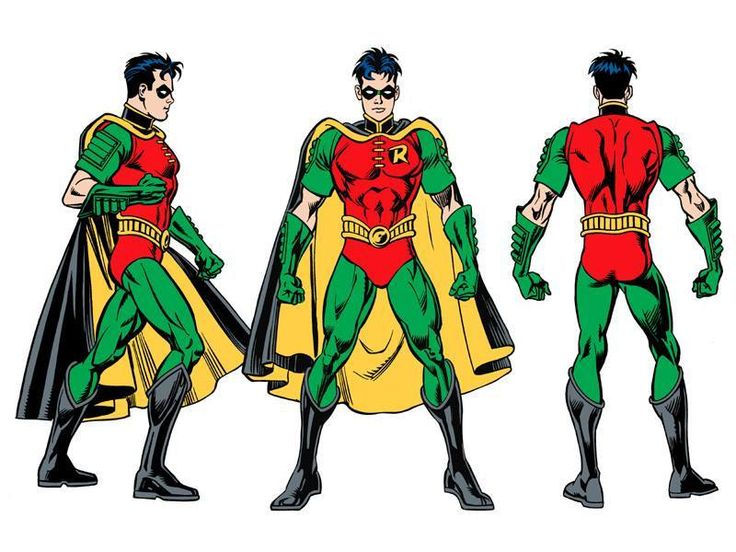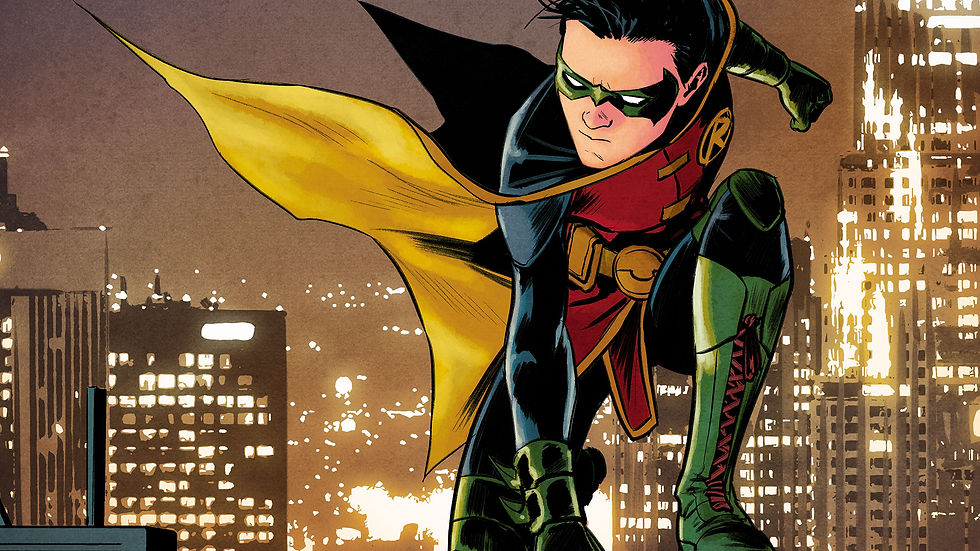Tony’s Superhero Saturdays™: ROBIN — The Red Thread That Binds the Bat
- Tyrone Tony Reed Jr.

- 3 hours ago
- 6 min read

Gotham breathes. Sirens flash against wet brick. A shadow moves—broad-shouldered, silent, inevitable. And then, streaking across the rooftop like a flare, comes a second silhouette: smaller, faster, brighter.Yellow cape. Red tunic. Green boots.
The city calls him Robin — and for more than eight decades, that red thread has stitched the Bat-Family together, turning fear into hope, solitude into partnership, and grief into legacy.
This is the story of every Robin — their victories, losses, failures, reinventions, and why Batman doesn’t just work with a Robin… he needs one.

Why Robin Exists (And Why It Matters)
When creators Bob Kane, Bill Finger, and Jerry Robinson introduced Dick Grayson in Detective Comics #38 (1940), they weren’t just adding a sidekick — they were injecting hope into a city drowning in grief.
“Batman needs a Robin,” future Robin Tim Drake would later declare in A Lonely Place of Dying (1989). That single line explains eight decades of storytelling.
Across every generation, Robin has symbolized balance and perspective — the courage to stare into horror and still smile.Robin is Batman’s heart made visible.
Dick Grayson — From Acrobat to Nightwing
The first and brightest. Created by Kane, Finger, and Robinson, Dick was a circus prodigy who watched his parents fall and found in Bruce Wayne not just a guardian but a mission. His early appearances (Detective #38–45) built the model for every partner to come.
“We save people. That’s the job.” — Dick Grayson
Under Marv Wolfman and George Pérez in The New Teen Titans, Dick matured into a leader. In The Judas Contract he shed the pixie boots, claimed the name Nightwing, and proved legacy isn’t rebellion — it’s growth. When he wore the cowl in Batman: Prodigal, he showed the student could equal the master without losing himself.

Jason Todd — The Fallen Robin, The Red Hood
Introduced by Gerry Conway and Don Newton in Batman #357 (1983) and later re-imagined post-Crisis by Max Allan Collins, Jason was a street kid stealing the Batmobile’s tires — and stealing Bruce’s heart.
Defiant compassion made him a different kind of Robin: passionate, reckless, real.
Then came Batman: A Death in the Family (1988) — the crowbar, the vote, the silence. Batman’s greatest failure became Gotham’s haunting.
Years later Under the Red Hood resurrected him with purpose.
“You let the Joker live.” — Jason Todd
“I do what you won’t to protect who you can’t.” — Red Hood
Jason’s new moniker turned trauma into agency — a Robin who couldn’t forgive the code but never stopped loving the cause.

Tim Drake — The Detective Who Saved the Mission
Created by Marv Wolfman and Pat Broderick, Tim Drake appeared in Batman #436 (1989). He deduced the truth — Bruce was Batman, Dick was Nightwing — and realized what the world had missed:
“Batman needs a Robin.”
That line resurrected hope.
Tim became the strategist, the steady mind who kept Gotham’s math from breaking. In Robin (1993 onward) and Red Robin (2010s) he evolved from partner to planner.
“Being afraid doesn’t make you weak. It makes you human.”
When he took the title Red Robin, he wasn’t rejecting his roots — he was future-proofing them.

Stephanie Brown — The Spoiler, The Robin, The Batgirl
Created by Chuck Dixon and Tom Lyle (Detective Comics #647, 1992), Stephanie entered Gotham as the Spoiler — a daughter of a villain determined to end his crimes.
Her grit earned her a brief, volatile turn as Robin (Robin #126–128) and later a joyful, self-assured era as Batgirl in Bryan Q. Miller’s 2009–2011 series.
“I don’t quit. I never quit.” — Stephanie Brown
Steph’s arc shows that heroism isn’t pedigree — it’s perseverance and heart.
Damian Wayne — The Son of the Bat
Created by Grant Morrison and Andy Kubert (Batman #655, 2006), Damian was born of Bruce Wayne and Talia al Ghul, building on the earlier “son of Batman” concept from Mike W. Barr & Jerry Bingham, and raised by assassins. He entered Gotham with a blade and a temper and had to learn that partnership is stronger than dominance.
“I am Robin.”
“I was trained to be a weapon. I chose to be a partner.”
Through Morrison’s Batman & Robin, Super Sons, and Robin (2021), he transformed from arrogant prodigy to empathetic heir. He remains the forge in progress — the son learning what love costs.

Beyond the Core Five: The Extended Robins
The mantle has reached beyond Gotham’s main continuity more than once—each bearer revealing what the “R” truly stands for.
Carrie Kelley, created by Frank Miller and Klaus Janson in The Dark Knight Returns (1986), reignited an older, broken Batman’s crusade. Her courage reminded readers that even a fading legend can be reborn through inspiration.

Helena Wayne, daughter of Bruce Wayne and Selina Kyle, first appeared in DC Super-Stars #17 (1977) by Paul Levitz and Joe Staton. On Earth-2 she followed in both her parents’ footsteps—trained by the Bat, tempered by the Cat—and for a time carried the Robin title before becoming the first Huntress. Helena’s story bridges generations: legacy made flesh, proof that Gotham’s light doesn’t stop at the city limits or even one world.
“I fight for my father’s mission — and my mother’s mercy.” — Helena Wayne, Huntress: Dark Knight Daughter

Duke Thomas, created by Scott Snyder and Greg Capullo (Batman Vol. 2 #21, 2013), turned the symbol into a movement through We Are Robin (2015) and later stepped forward as The Signal, Gotham’s daytime guardian.
Together, Carrie, Helena, and Duke prove that the “R” belongs to anyone brave enough to believe in it — and that Gotham’s family tree has branches in every era, universe, and heart willing to rise against the dark.

Themes and Evolution
Every Robin changes moniker but never mission.
Dick → Nightwing to grow.
Jason → Red Hood to reclaim agency.
Tim → Red Robin to lead independently.
Stephanie cycles through roles to define herself.
Damian stays Robin because he’s still forging his heart.
Helena becomes Huntress to merge justice with mercy.
The symbol remains Gotham’s promise that light still answers the call.

Defining Victories and Wounds
The Judas Contract (Nightwing’s birth)
A Death in the Family (Jason’s sacrifice)
Under the Red Hood (the reckoning)
A Lonely Place of Dying (Tim’s deduction)
Batgirl (Miller) — Stephanie’s joy as competence
Batman & Robin (Morrison) — Damian’s growth
We Are Robin / The Signal — the mantle as movement
Huntress: Dark Knight Daughter — Helena’s bridge between Bat and Cat
In Gotham, failure is curriculum, not conclusion.

Why Batman Needs Robins
Because strategy without soul collapses. Each Robin anchors a different part of Bruce Wayne’s humanity:Dick the heart, Jason the conscience, Tim the logic, Stephanie the empathy, Damian the legacy, Helena the balance of justice and grace.
Together they turn vengeance into virtue.
“The mission breaks you if you do it alone.” — Batman

Voices and Faces of the R
Live Action
Burt Ward (Dick Grayson, Batman 1966) • Chris O’Donnell (Dick Grayson, Batman Forever, Batman & Robin) • Brenton Thwaites and Curran Walters (Dick Grayson and Jason Todd, Titans) • Jay Lycurgo (Tim Drake, Titans) • Joseph Gordon-Levitt (Robin John Blake, The Dark Knight Rises).
Animation
Loren Lester, Scott Menville, Jesse McCartney, Jensen Ackles, Mathew Valencia, Cameron Bowen, Mae Whitman, Stuart Allan, Jacob Tremblay — each brought a new voice to the legacy.
Their combined work turned “sidekick” into synonym for steadfast.
“They’re not soldiers. They’re my family.” — Batman, Justice League Unlimited
Why They Endure: Creators and Continuity
From Kane and Finger’s 1940 boy wonder to Morrison and Kubert’s modern heir, every writer and artist reinterprets the same truth: Robin is the light that makes the shadow mean something. Even outside canon (The Dark Knight Returns, Elseworlds, We Are Robin), the idea stays constant — someone must choose hope first.

The Philosophy of the R
The R is a rescue line—it keeps Batman from drowning in rage. It’s a relay baton—the mission passes but never ends.It’s a mirror—reminding Bruce what he fights for: people.And it’s a promise—that no one in Gotham fights alone.
Where to Start (Reading & Viewing)
Detective Comics #38 (1940) — The beginning
The Judas Contract — Graduation
A Death in the Family / Under the Red Hood — Fall and forgiveness
A Lonely Place of Dying — Restoration
Batgirl (Bryan Q. Miller) — Joy as justice
Batman & Robin (Morrison) — Father and son
We Are Robin / The Signal — The people’s mantle
Huntress: Dark Knight Daughter — Her story of legacy and mercy
Animation: Batman:The Animated Series, Teen Titans, Under the Red Hood, Son of Batman, Harley Quinn.
The Mission Statement in Red
Robin is a safety line for Batman and a runway for every generation after.Robin proves Gotham can be taught, not just terrified.Robin is inheritance and invitation — the job continues because the love does.

Final Word — The Red That Makes the Black Mean Something
Batman is terror turned to purpose. Robin is sorrow turned to song. Every flash of yellow cape through Gotham rain whispers the same truth: We still believe. That’s why the mantle survives, why the mission evolves, and why the Bat-Family endures.
🕯️👉🏾 Read more heroic inspiration and pick up autographed copies of S.O.L.A.D.™: Soldiers of Light Against Darkness™ novels at www.tyronetonyreedjr.com/the-shop.



Comments